The Secret Lives of Turkeys
By Alan Krakauer
Editor’s Note: Alan is a biologist living in Richmond. He is broadly interested in evolution, ecology, and natural history. Most of his research has focused on the behavioral ecology of birds. To learn more about Alan’s life and work, you can go to his WEBSITE. Alan also has a Nature PHOTOGRAPHY WEBSITE, complete with his lovely photographs. Through the end of December he is offering 10% off purchases to friends of GGBA at his online store and donating 5% of his sales to GGBA during this period.
Everyone thinks of November as Turkey Time, but if you are a wild turkey (or turkey watcher), spring is when much of the action happens. Males are still gobbling for attention and fanning their tails to woo females. Meanwhile, hens that have already nested are cautiously chaperoning their broods of adorable fluffy poults. Spring provides a glimpse into the secret social lives of Meleagris gallopavo. In reality, although turkeys are often considered avian simpletons, they actually sport one of the most complex societies of all birds!

PART 1: Mating System: How males and females are organized
Let’s start with the dating life of a wild turkey. Turkeys are an odd bird in the spring. The vast majority of bird species grow up in some variation of a nuclear family– a mother and a father tending a nest and raising their offspring together. Raising hungry kids is hard and fraught with danger, so dual-parenting usually makes sense as a strategy to ensure those chicks survive and get out of the nest as quickly as possible.
Not so with turkeys. The hen can incubate on her own and the poults can feed themselves once they hatch. Over the period of a day or so, they hatch and leave the nest site for good. Male turkeys have one job (standing in the street blocking traffic is more of a hobby, ha!), and that’s to mate with hens. As far as we know they aren’t aware of where the nests are located and don’t hang out with the moms before or after the poults leave the nest.
Especially in areas with lots of turkeys, the ways that males and females get together for courtship can be a complex affair. Their mating system is a unique blend of several breeding strategies and hard to put under one specific label. Like sage-grouse, prairie chickens, or other lek-breeding birds, spring groups of turkeys can contain multiple males and multiple females all interacting with each other. And yet similar to true harem birds like Ring-necked Pheasants, fertile females walk around in groups and males try to guard these groups and keep other males away.

Turkeys tend not to be so well organized as either of the previous examples. Females spread out on the landscape to nest, meaning the larger groups you find at the end of winter will split up into smaller and smaller units as they explore for good places to lay their eggs. As females start incubating they spend almost all their time alone on the nest and disappear from these hen flocks. At the same time, other females may re-appear if their nest fails and they want to give it another go. This makes it tough for males to predict when, where and how many hens will show up in any one spot. Some hen groups may get several suitors, yet males may also have to do some running around, gobbling, and looking for better courtship opportunities.
There’s one even more unusual twist to the turkey mating system– the males are sometimes working together in teams that court and defend females together! We’ll talk more about this later in Part 2.
The Mating Game
No one can honestly say that a male turkey is not a fancy bird. We tend to take them for granted now that they are everywhere, but the shiny plumage, large radar dish of a tail, sharp spurs, hair-like beard poking out of the middle of their breast, and other unusual ornaments of the male make for an absolutely stunning bird. What do female turkeys find irresistible about the male’s appearance?
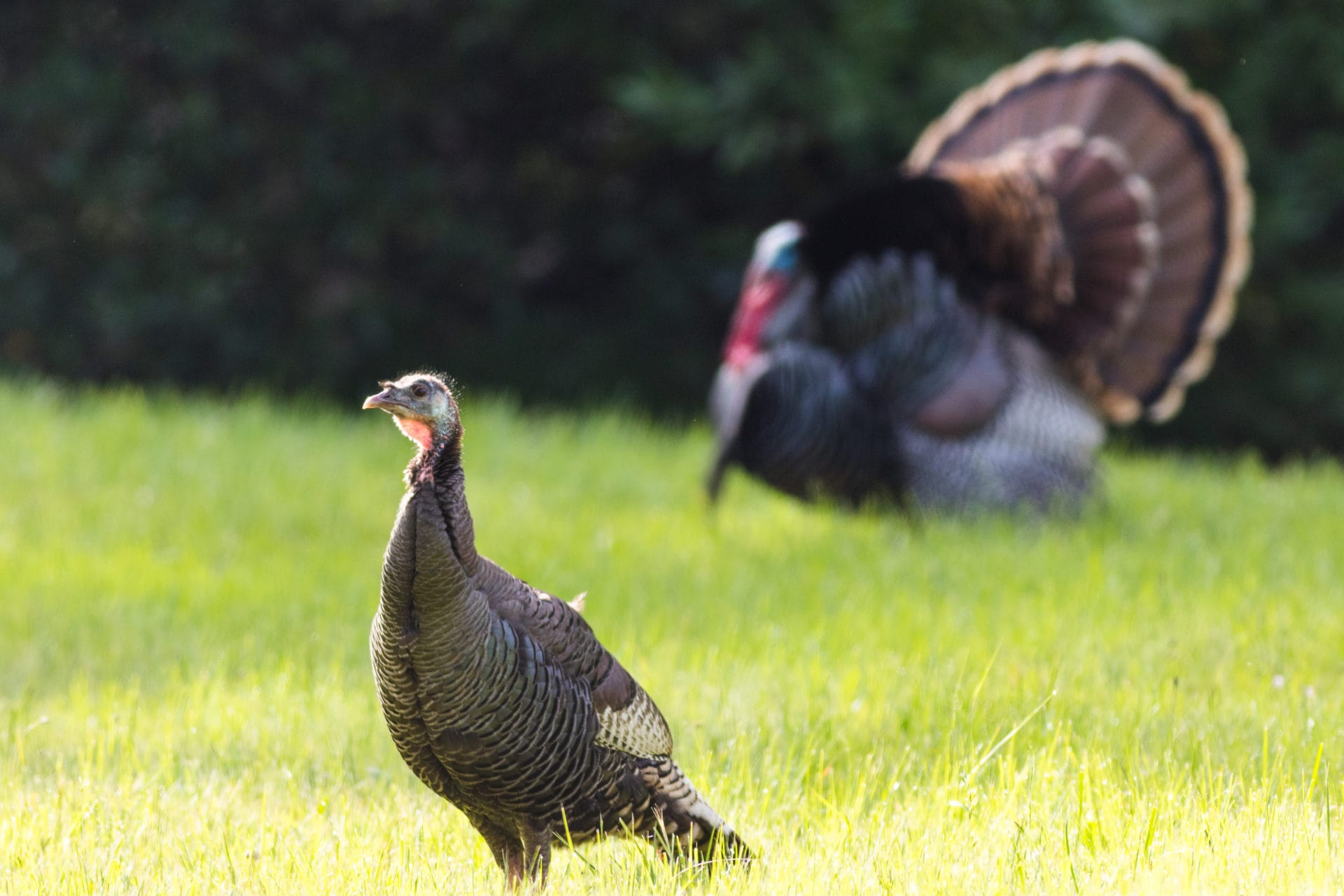
Dr. Richard Buchholz of the University of Mississippi conducted a series of studies using captive-raised wild turkeys to try to understand what females like. Surprisingly, he found females didn’t obviously care about most of these fancy traits. The one ornament that stood out in his experiments was the snood, the familiar distensible wattle that sits just over the male’s beak. Females like males with longer snoods. Dr. Buchholz also found that hunter-killed males with longer snoods tended to have fewer parasites. Females may be choosing males for their genes: pick a good male and your kids will have a better chance to fight off diseases down the road.
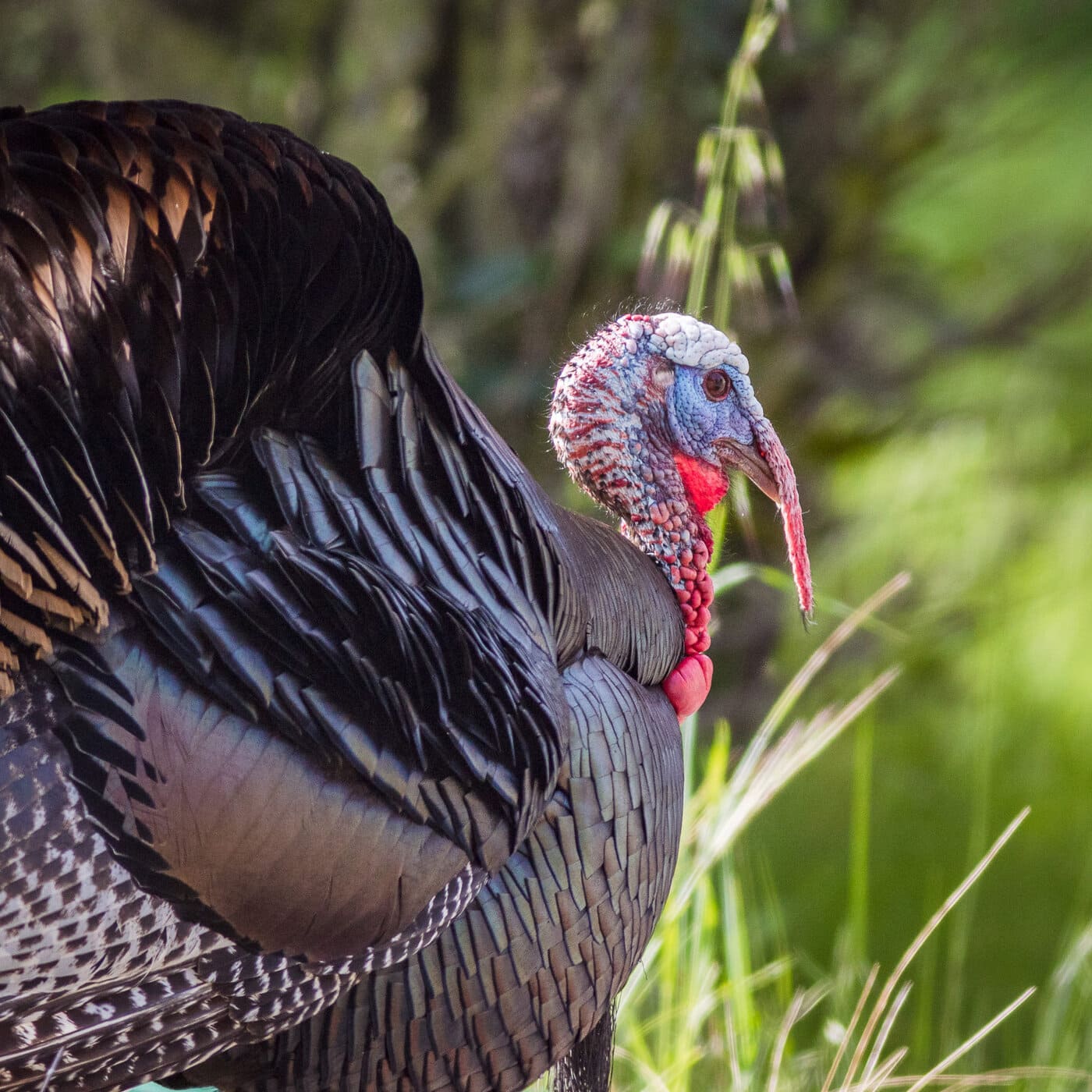
That said, there’s a lot that we still don’t know about the male’s spring show. Do hens care about the gobble (presumably a long-distance call) or the low frequency hum that accompanies the strut (presumably for short-distance communication)? Why do males drag their wings on the ground, going so far as to grind off the ends of their primary wing feathers, and do they seek out noisier areas to do this? Do females choose a dude based on the color of the males’ feathers or skin? Are they flashing ultraviolet signals like peacocks do? In my previous studies of sage-grouse, we found some evidence that the top males know how to “read the room” and not come on too strong to a female who’s still making up her mind. Are these social skills a big part of turkey courtship as well? Answers to these questions are waiting for future bird biologists to tackle.
The story gets even more complicated once we think about how this mating game plays out in nature. Hens may have their preferences, but the list of males on the menu depends on the dominance hierarchy in the flock. Top males will get to display close to the female, and lower ranking males either wait in the wings or wander looking for other opportunities. In some cases competition among males may reinforce what the female wants for herself– for example Dr. Buchholz found the males with longer snoods tended to win against males with shorter snoods.
There is one particularly important way males can get a big leg-up on the competition– join together! But why would males risk everything to help another male win at the mating game?
PART 2: All in the Family. Turkey Brothers?
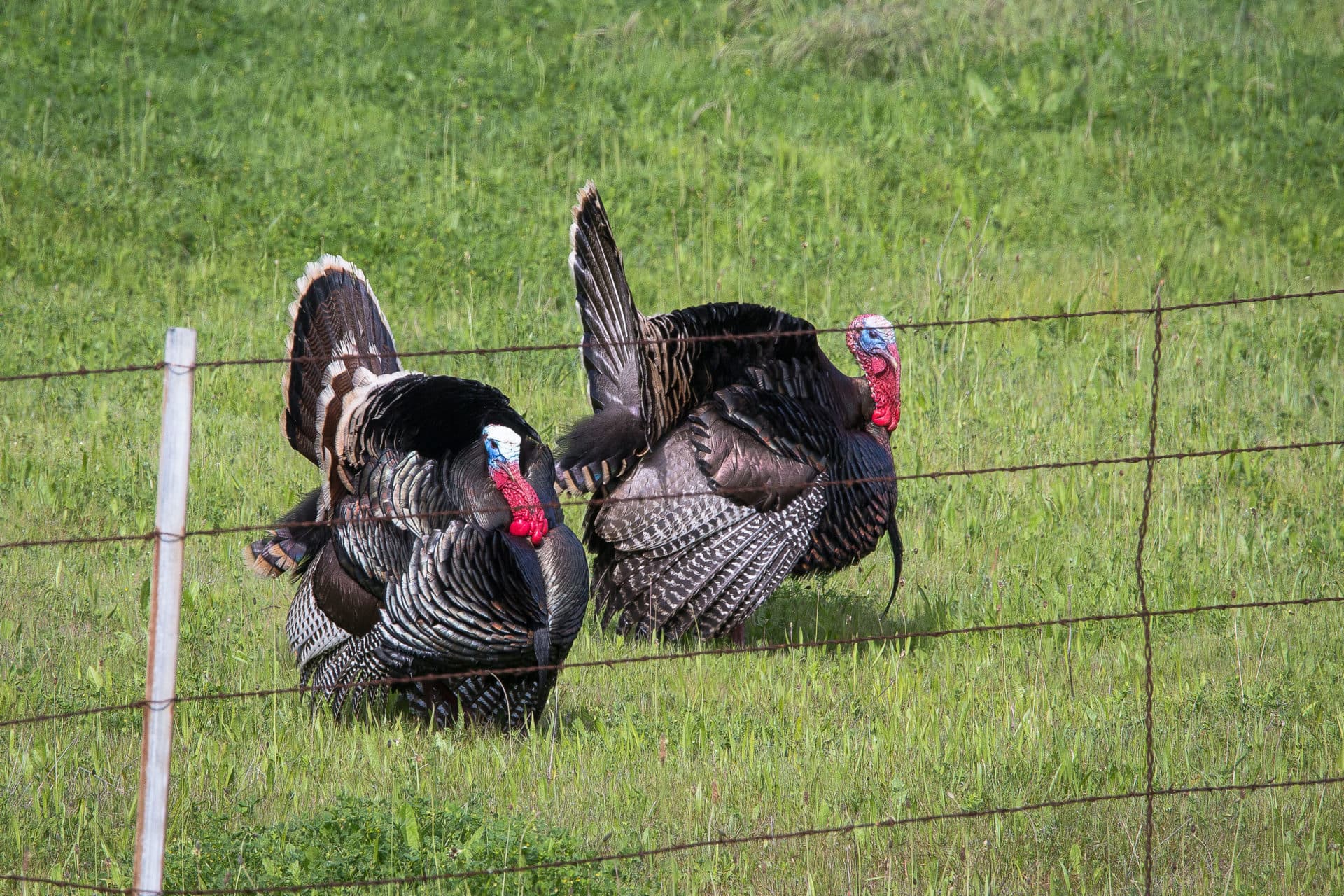
Turkey teamwork first came to light during a graduate dissertation in the Texas hill country during the 1960’s. C. Robert Watts, a student at Utah State University, observed groups of two up to four males that courted females together and also fought together against other males or male groups. He watched fields where the males and females congregated and saw these teams were dominant over single males and got more matings than single males as well. The most interesting observation was that within each team, at most only one male got to mate. According to Watts, the “wingmen” failed to mate at all. When they weren’t acting as back-up dancers, they were busy keeping other males at bay so the top male could work his magic with the females without interruption. Why would the other males in a team bother to help, when they don’t appear to get anything out of the bargain?
Watts seized on a new theory called kin selection to explain these teams. The males in each unit looked to be the same age, and Watts believed they were brothers. Siblings share a mother and father, and therefore share many of the same variants of their DNA passed on through those common parents. The insight from kin selection is that when one relative helps another reproduce more than they otherwise would, then they are indirectly passing on some of their own genes. This was an important expansion of how natural selection can work, and helps to explain (some cases of) cooperation in the animal kingdom that didn’t fit with the original ‘survival of the fittest, every bird for themselves’ framing of Darwin and Wallace’s big idea.
In the context of the turkeys, the kin selection story plays out in the following way. One male serves as body guard and wingman to his brother. The helping brother is providing familial support, meaning the dominant brother may mate with more hens than he would if he courted alone. Even if the subservient wingman never mates himself, evolutionarily he gets some credit for the offspring of these additional hens that his brother only mated with because of his help.
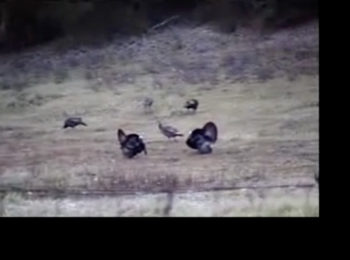
To view Alan’s full video on YouTube, please click here.
Watts’ Texas turkey study dropped at a very opportune moment. The concept of kin selection was drawing a lot of attention in the field. Science ambassadors and educators were hunting for intuitive examples of animals helping their family in nature. The Watts study, mostly on the strength of a Scientific American article that was not peer-reviewed (subject to comments and concerns from other scientists) eventually found its way into textbooks.
Yet as quickly as the story gained traction, the kin selection interpretation seemed to crumble. Another graduate student returned to conduct a follow up study, but by then the population had crashed and the cooperative behavior had disappeared (and unbeknownst to me, at least two other graduate students had also tried to replicate the study elsewhere but due to various logistical difficulties they eventually switched dissertation topics). Other scientists, even including a member of Watts’ own committee, called into question whether Watts’ data were sufficient to support the conclusions he made. With some of its luster lost, newer textbook editions minimized or omitted the turkey study altogether.
Yes, Brothers!
This is where I came into the story. Watts lacked direct evidence of kinship within the male partnerships, and his turkey watching days were decades before we were able to use DNA to sleuth out these familial ties. Without that genetic evidence, the kin selection story lacked key supporting data… and yet, as turkey populations surged towards the end of the last century, more and more people were starting to notice these courtship teams again. Something has to explain this unusual behavior of males apparently cooperating during the breeding season. What was going on?
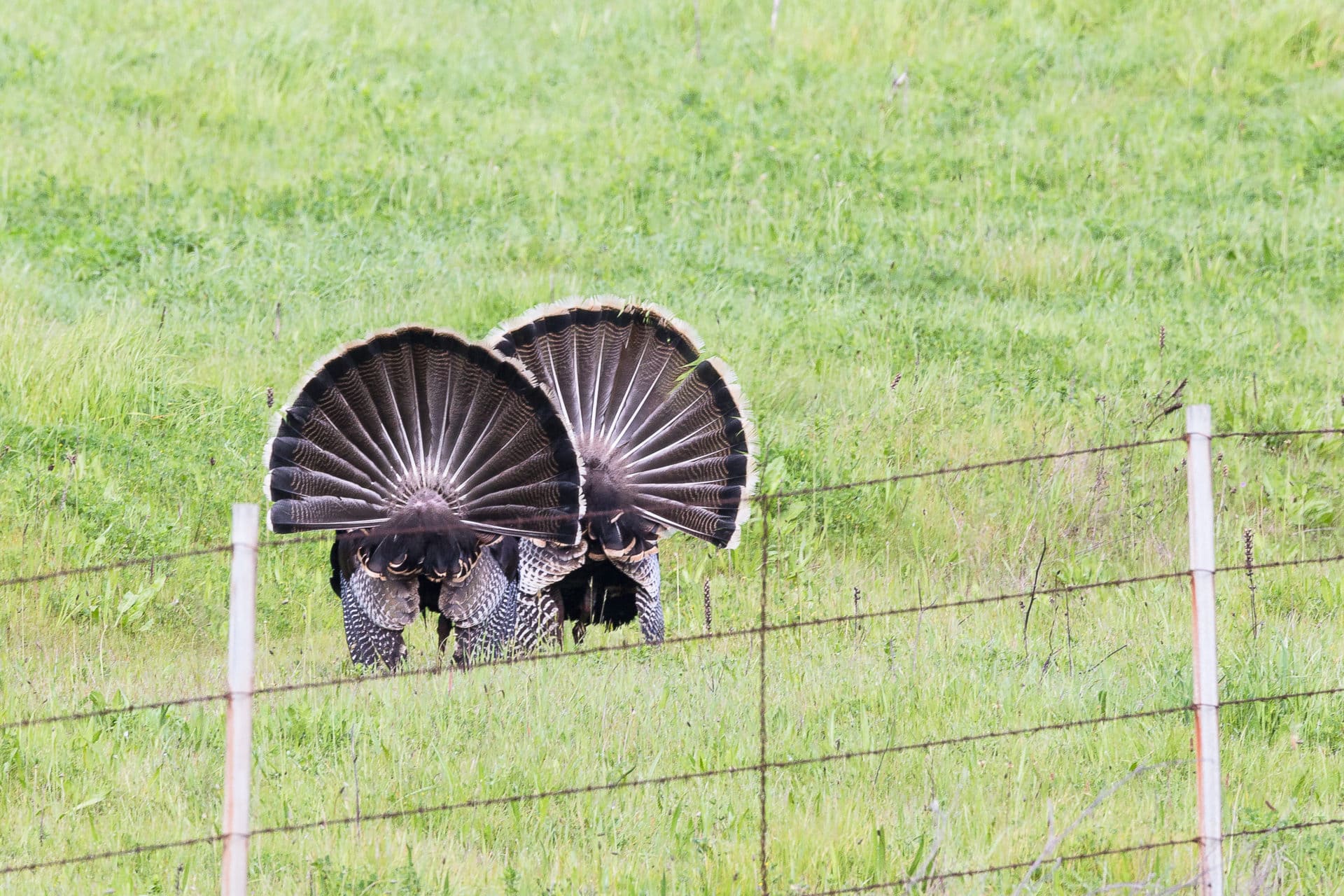
Enter me, a new graduate student at UC Berkeley. I moved to California in the late 1990s. Hard to believe now, but this was before one could so easily find turkeys in most parts of the Bay Area. One of my advisors, Dr. Walter Koenig, was a research zoologist at UC Berkeley’s Hastings Natural History Reservation in Monterey County and an expert on cooperation in birds. He saw these turkey groups around the reserve, and thought they might tell a good story whether or not they were brother bands. Like many birders, I didn’t necessarily think of turkeys as ‘real birds’ and I hadn’t started grad school expecting to tackle turkey mysteries. Long story short, I ended up following in Watts’ footsteps and, in the end, showing most of his ‘too good to be true’ story was actually correct!
With DNA technology now part of the biologist’s toolkit, I was able to answer some of the important unknowns from that Texas study. First, yes, the males that displayed to hens as a team were related, on average somewhere between half-brothers and brothers (more on this in Part 3). Second, the team leaders on average sired many more offspring than solitary males that lacked wingmen. And finally, the wingmen never bred (while their partner was alive at least), and in agreement with the predictions of kin selection, they got more benefit from helping their brother than expected had they struck out on their own and tried life as a single male. Watts’ hunch about the system turned out to be spot on!
Before I move on, I want to point out that kin selection isn’t the only explanation for helping behavior in animals, nor are turkeys completely unique in having males team up like this. For example, a few species of manakins (small colorful lekking birds from the New World tropics) form “dance teams” where two or more males perform intricate leapfrog dances to impress watching females. Like the turkeys, only the alpha male in each crew gets to mate, but unlike the turkeys, these males are not relatives. Without genetic relatedness, kin selection can’t make sense of why the back-up dancers would help the star. In the case of these long-lived manakins, it’s more like an apprentice program, where the lower-ranked helpers have a better chance of becoming the alpha in the future.
Here is a video example of duetting Chiroxiphia (otherwise known as Lance-tailed) Manakins.
PART 3: Birth of a Brother Band
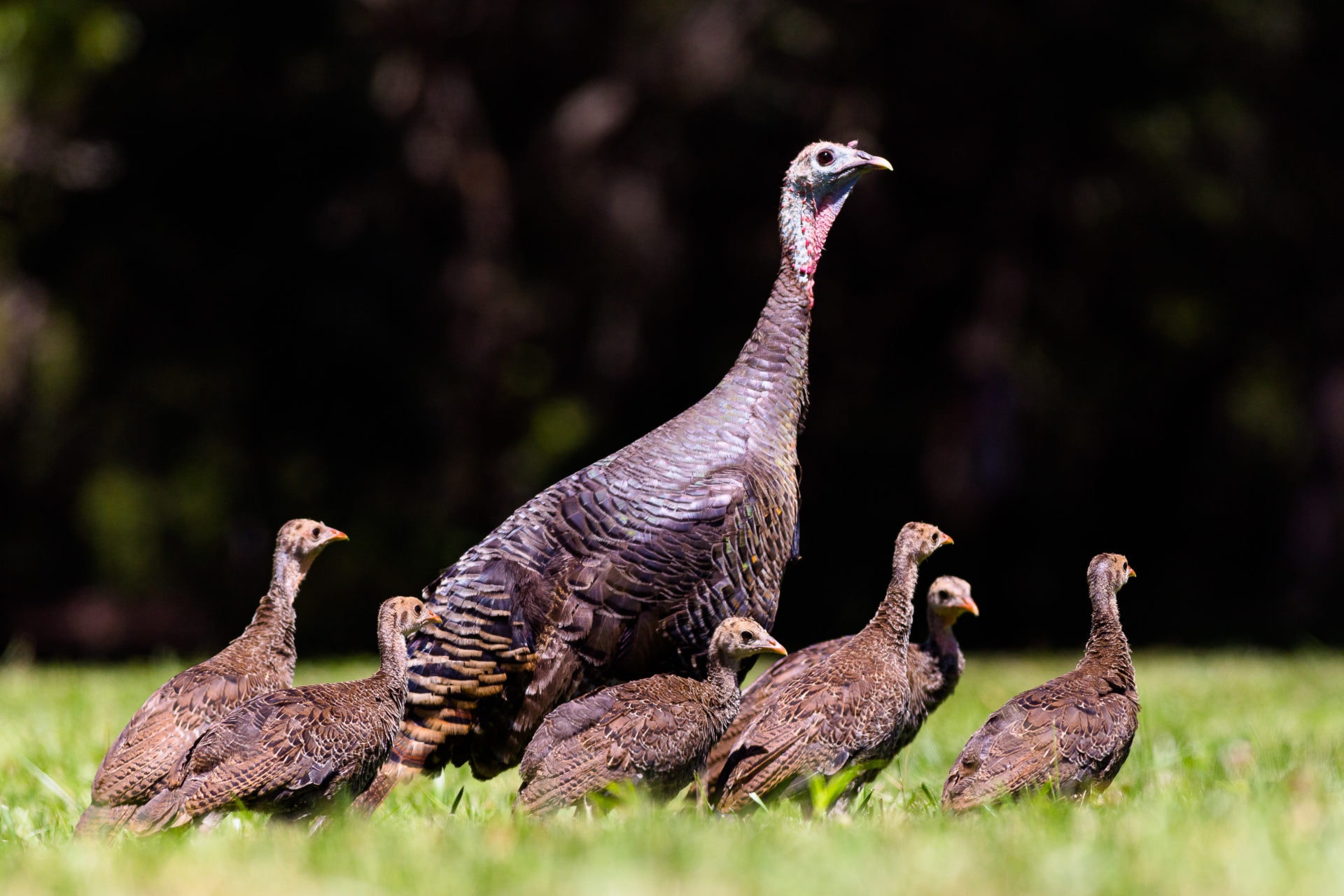
The Watts’ study suggested that the male coalitions were brothers helping brothers. Fast forward 35 years, and the DNA evidence revealed more complexity in the situation. What are the mating patterns in wild turkeys? If you look at a typical turkey nest, is everyone a full sibling? I was able to answer this for a sample of nests in my Monterey study area.
About half of the nests would have met Watts’ expectations, containing exclusively genetic full siblings (i.e. one hen and one tom only). And the rest? Close to half the hens had mated with two (or more) males. Evidently there can be more than one ‘Mr. Right’!
Add to that several nests in which a few eggs were laid by other turkey hens. Wait, what? I had found genetic evidence of conspecific brood parasitism, a behavior most often seen in waterfowl. To make matters more complicated, for some of these parasitic eggs the two females both mated with the same male!

All this complexity means the typical eight to twelve eggs in a turkey nest can hatch out a mix of full siblings, paternal half-sibling, maternal half-siblings, and even a few unrelated birds!
We still don’t know exactly how we get from a brood of tiny poults to a team of two or more males two years later. We do know that after hatching, moms and their babies will soon join together with other moms and their babies creating a crèche. Hens who did not successfully nest typically flock apart. By the fall and winter, all the hens in the population will come together with their young, and by winter or early spring the almost one-year old males will start to hang out more with the older males. These one-year olds are smaller than older males and it’s not until the following year when males or male teams have a real shot at the females.
Power Dynamics
One last question is who gets to be the leader, and who is stuck with the wingman/bodyguard role? We still don’t know if there is anything that predicts which male comes out on top. We do know it requires more than a gentleman’s game of Rock-Paper-Scissors to determine the winner. Watts described the vicious brawls between the leader and his helper. Wing smacks, kicks, pecks to the head, sumo-like shoving matches, it’s anything goes! The fights won’t end until one male yields. While wingmen end up satisfied with their lot if they lose, it’s certainly worth fighting to become the breeding male in the group. In the words of Mel Brooks in History of the World, Part I, “It’s good to be the king.”
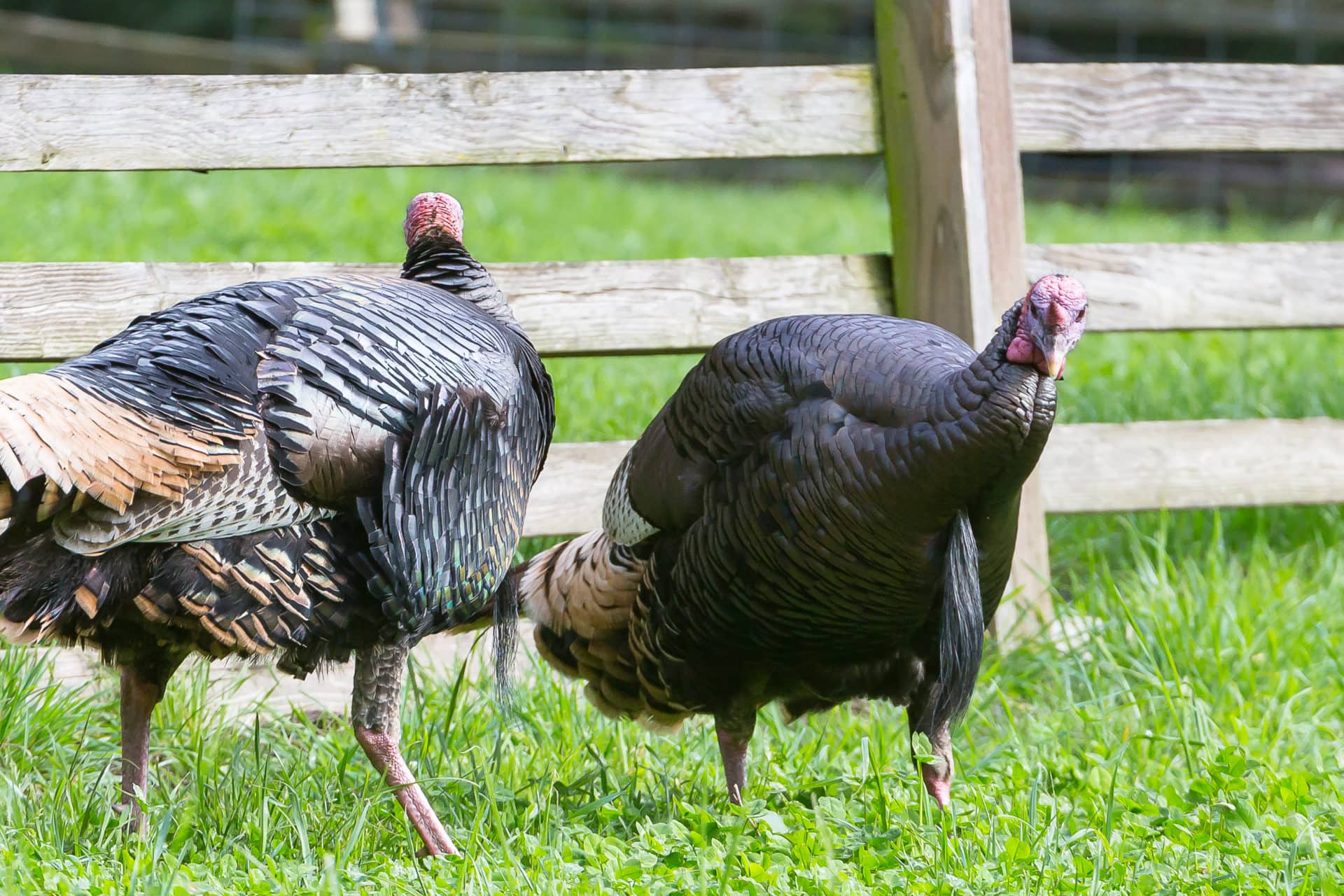
Males reexamine this power structure every year once breeding is over. Although these contests can lead to the intense fights Watts described, they don’t always start out that way. I noticed right after the breeding season, the dominant male would engage in long periods of pestering of his partner, presumably to maintain the status quo in their relationship. My sense from watching this behavior play out is that the top male is trying to get in position to peck at his subordinate, and that subordinate turns away to avoid that from happening, so the top male turns again, leading to sometimes many minutes of the turkeys comically walking around in circles.
Here is an example of this circling behavior.
In my fairly limited sample from Monterey County, I never saw a top male lose his position. However, top status may not always be a lifetime appointment. I’ve been told about dominance switches in a Michigan population, although these observations were never published. Getting to take over a team would be an extra benefit for the wingman if it works out. Yet even if he stays as a helper his whole life it still beats striking out on his own and having to compete against other turkey teams by himself.
An important point about these within-team power struggles– they usually happen separate from courtship. Any chasing or fights you might see during the breeding season are likely to be between male groups as they jostle for dominance and protect their access to local hens.
In contrast, sibling disputes seem to simmer under the surface; why risk compromising a courtship attempt? Imagine two males having to fight out who gets to mate every time a female comes by. Not only would this be taxing for the males but females may not have the patience to wait around for a winner to be decided.
Conclusion
Turkeys don’t have a reputation for being brainiacs. They may not look like the sharpest tool in the shed when they are standing in the middle of an intersection or trying unsuccessfully to run through a chain-link fence. They don’t have the problem-solving chops of crows or ravens, the spatial memory of scrub-jays stashing their autumn acorns, or the impressive song repertoire of a mockingbird. However, I hope I’ve convinced you they are anything but boring.
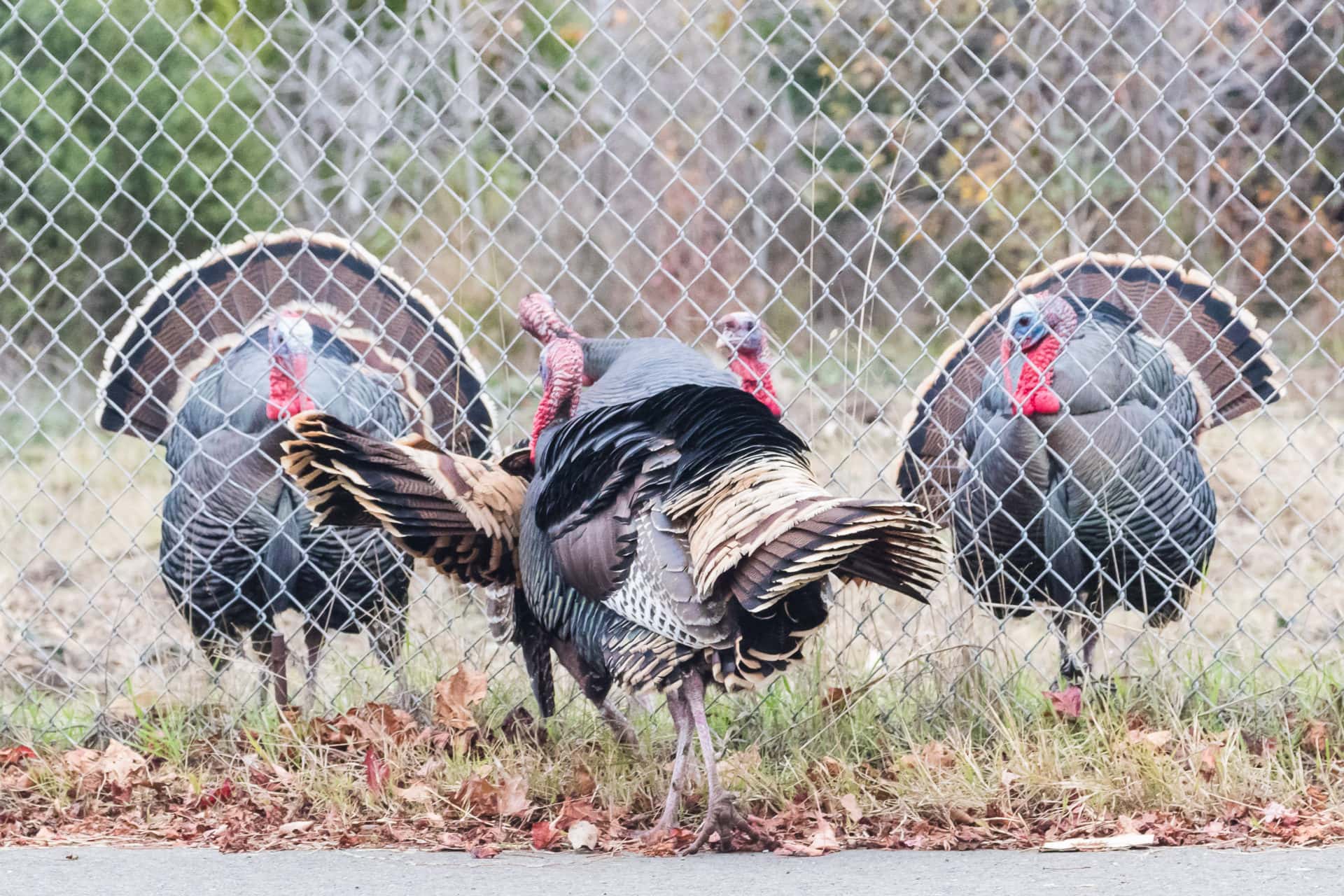
First, they are incredibly social creatures. They live in a world with complex dominance hierarchies (in both sexes), navigating an ever-changing social world searching for food, shelter, and mates. Especially when we get closer to spring, turkey flocks will become dynamic – crackling with tension between conflict and cooperation.
Second, they develop some of the strongest family ties of any animal. While the relationships between male siblings pass through periods of bitter struggle, these males forge life-long partnerships most likely starting from their first days out of the egg. These relationships are so central that to help their relative some males forgo breeding for their entire lives.
Clearly there is a lot this species can teach us about animal behavior. Even so, there is still just as much we don’t know. I’m confident future biologists will add onto this story and in time there will be even more surprises about our most irritating, most beautiful, most interesting bird!
Have an interesting blog you’d like to share with us? Email Melissa your 800-1200 word essays at mr****@********************ce.org.
